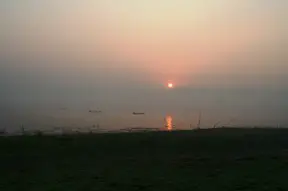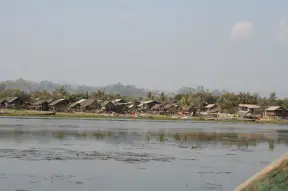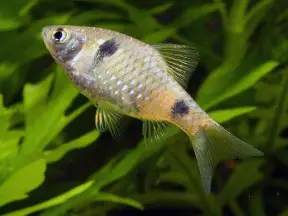Pethia didi
SynonymsTop ↑
Puntius didi Kullander & Fang, 2005
Etymology
Pethia: the generic vernacular name for small cyprinids in the Sinhala language.
didi: named for the authors’ son Didi (Mandarin Chinese, meaning earth, little brother). In contrast to the similar P. tiantian, P. didi is a species of the lowlands, steady on earth.
Classification
Order: Cypriniformes Family: Cyprinidae
Distribution
The type series was collected from various localities within the Ayeyarwady River drainage in the vicinity of Lake Indawgyi and city of Myitkyina, Kachin State, northern Myanmar, and the species appears to be endemic to the area.
Type locality is ‘Hpa Lap Chaung just south of Yuzana Myiang village, 8 kilometers left from Myitkyina-Myitzon road kilometer 11, 25°31’25″N, 97°22’19″E’.
Habitat
The type locality is a stream with a mixed substrate of mud and stones which flows swiftly through an area of bamboo forest so is quite well-shaded.
At time of collection the water was clear but slightly tannin-stained and sympatric species included Pethia thelys, Puntius sophore, Devario strigillifer, Rasbora daniconius, R. rasbora, Acanthocobitis botia, Notopterus notopterus, plus unidentified species of Oreichthys, Parambassis, Xenentodon, and Mastacembelus.
At other localities it was found living alongside numerous other fishes from Acanthocobitis, Schistura, and Danio to Badis, Dario, Pillaia, Indostomus and Microphis species.
Biotopes were all relatively similar having algae-encrusted rocks or leaf litter as substrate.
Maximum Standard Length
35 – 41 mm.
Aquarium SizeTop ↑
Base dimensions of at least 60 ∗ 30 cm or equivalent are required.
Maintenance
Choice of décor is not especially critical though it tends to show better colouration in a heavily-planted set-up with a dark substrate.
The addition of some floating plants and driftwood roots or branches to diffuse the light entering the tank also seems to be appreciated and adds a more natural feel.
Filtration does not need to be particularly strong though it does seem to appreciate a degree of water movement and will also do well in a hill stream-type set-up.
Water Conditions
Temperature: This species is subject to seasonal temperature fluctuations in nature and should be comfortable between 15 – 25 °C.
pH: At the type locality the pH was 6.5 but this is unusual for northern Myanmar and probably varies over the course of the year. The usual recommended range for fishes of this region is 6.5 – 9.0.
Hardness: Inhabits soft waters so aim for somewhere within the range 18 – 90 ppm.
Diet
Wild fish are probably foragers feeding on diatoms, algae, organic detritus, small insects, worms, crustaceans, and other zooplankton.
In the aquarium it’s easily-fed but the best condition and colours offer regular meals of small live and frozen foods such as bloodworm, Daphnia, and Artemia alongside good quality dried flakes and granules, at least some of which should include additional plant or algal content.
Behaviour and CompatibilityTop ↑
Generally very peaceful making it an ideal resident of the well-researched community aquarium.
Fishes inhabiting similar biotopes in nature, especially comparably-sized, open water-dwelling cyprinids perhaps constitute the best choices but other potential options include balitorid, cobitid, and nemacheilid loaches as well as benthic cyprinids such as Crossocheilus or Garra species.
Quite a few fishes from the Ayeyarwady basin are available in the aquarium trade including Danio choprae, D. albolineatus, D. kyathit, D. tinwini, Devario apogon, D. shanensis, Pethia stoliczkana, P. padamya, P. tiantian, P. ticto, Acanthocobitis botia, Schistura vinciguerrae, Lepidocephalichthys berdmorei, and Crossocheilus latius.
As always research your planned combination before purchase in order to avoid problems.
Try to buy a mixed-sex group of at least 8-10 specimens, include other schooling fishes to provide security, and you’ll be rewarded with a more natural-looking spectacle.
The interaction between rival males is fascinating to watch and they will display their best colours when competing for female attention or hierarchical position.
Sexual Dimorphism
Adult males are noticeably smaller, slimmer, and more colourful than females, especially when in spawning condition.
Reproduction
We’re yet to receive details of a successful aquarium spawning but recommendations for related species are as follows:
Like most small cyprinids Pethia spp. are egg-scattering free spawners exhibiting no parental care.
When in good condition they will spawn often and in a mature aquarium it’s possible that small numbers of fry may start to appear without intervention.
However if you want to maximise yield a more controlled approach is required.
The adult group can still be conditioned together but a smaller aquarium should also be set up and filled with mature water.
This should be very dimly lit and the base covered with some kind of mesh of a large enough grade so that the eggs can fall through but small enough so that the adults cannot reach them. The widely available plastic ‘grass’-type matting can also be used and works well, as does a layer of glass marbles.
Alternatively filling much of the tank with a fine-leaved plant such as Taxiphyllum spp. or spawning mops can also return decent results.
The water itself should be of slightly acidic to neutral pH with a temperature towards the upper end of the range suggested above, and an air-powered sponge filter or air stone(s) should also be included to provide oxygenation and water movement.
When the adults are well-conditioned and the females appear gravid one or two pairs should then be introduced, and spawning should take place the following morning.
An alternative is to spawn the fish in a group with half a dozen specimens of each sex being a good number, although a larger aquarium may be necessary.
In either situation the adults will probably eat the eggs given the chance and should be removed as soon as any are noticed.
These should hatch in 24 – 48 hours with the fry free swimming around 24 hours later.
They should be fed on an infusoria-grade food for the first few days until large enough to accept microworm, Artemia nauplii, or suchlike.
NotesTop ↑
This species is rare in the aquarium trade though it has been available occasionally.
It was formerly included in the Puntius conchonius ‘group’ of closely-related species alongside P. ater, P. bandula, P. conchonius, P. cumingii, P. erythromycter, P. gelius, P. khugae, P. macrogramma, P. manipurensis, P. meingangbii, P. nankyweensis, P. nigripinnis, P. nigrofasciatus, P. padamya, P. phutunio, P. punctatus, P. reval, P. shalynius, P. stoliczkanus, P. thelys, P. tiantian, and P. ticto, but all of these were moved to the new genus Pethia by Pethiyagoda et al. (2012), as were P. melanomaculata, P. pookodensis, P. muvattupuzhaensis, P. ornatus, and P. yuensis.
‘Puntius‘ narayani was not moved to the new genus and is currently of uncertain generic placement since it uniquely possesses 9 branched dorsal-fin rays and 6 branched anal-fin rays.
Pethia species are defined by the following combination of characters: rostral barbels absent; maxillary barbels minute or absent; possession of a stiff, serrated last unbranched dorsal-fin ray; presence of a black blotch on the caudal peduncle, and frequently, black blotches, spots or bars on the side of the body; infraorbital 3 deep and partially overlapping the preoperculum.
In P. didi the flank markings comprise two black, vertically-orientated blotches, one posterior to the operculum and the other on the caudal peduncle.
This colour pattern is also present in several congeners, some of which can appear quite similar on first appearances, but they can all be told apart by combinations of external characters.
For example, P. didi is most easily told apart from P. cumingii by possession of 12 (vs. 10) circumpeduncular scales and 3 ½ scales above the midline (vs. 4 ½), and is a deeper-bodied fish than P. meingangbii with a body depth of 40.4-48.2 % SL (vs. 35.4-39.8 %).
It differs from P. tiantian in possession of a thick, strongly-serrated last unbranched dorsal-fin ray (vs. last unbranched dorsal-fin ray slender, flexible and with short serrations posteriorly), body depth 40.4 – 48.2 % SL (vs. 35.4 – 39.8 %), dorsal fin length 26.6 – 31.8 % SL (vs. 23.2 – 26.0 %), lateral line with 6-7, rarely 10, perforated scales (vs. extending to base of caudal-fin), and males with two series of black marks in dorsal-fin and one series in anal-fin (vs. a single dark band in each fin). The head profile is also relatively steeper in P. didi vs. P. tiantian.
Younger specimens may be confused with P. phutunio but that species has additional markings on the body below the dorsal-fin base both anteriorly and posteriorly as well as only 10 (vs. 12 in P. didi) circumpeduncular scales.
The genus Puntius was for a number of years viewed as a polyphyletic catch-all containing over 100 species of small to mid-sized cyprinid until Pethiyagoda et al. (2012) published a partial review covering South Asian members.
The majority of sub-Himalayan Puntius species were reclassified and new genera Dawkinsia, Dravidia, and Pethia erected to accomodate some of them, with the remainder either retained in Puntius or moved to the existing Systomus assemblage, though the definition of the latter was altered meaning some Southeast Asian species formerly placed there are no longer members.
It subsequently became clear that the name Dravidia was preoccupied by a genus of flesh fly, therefore the replacement name Haludaria was made available by Pethiyagoda (2013).
No species from Indochina, China, or Indonesia were included in the study meaning a significant number of former Puntius are currently classed as incertae sedis, i.e., of uncertain taxonomic placement, and this also applies to a number of South Asian species of unresolved status.
They’re perhaps best referred to as ‘Puntius‘ for the time being whereby the genus name is surrounded by quotation marks to denote its questionable usage, and that is the convention used here on SF at the moment.
References
- Kullander, S. O. and F. Fang, 2005 - Copeia (2): 290-302
Two new species of Puntius from northern Myanmar (Teleostei: Cyprinidae). - Pethiyagoda, R., 2013 - Zootaxa 3646(2): 199
Haludaria, a replacement generic name for Dravidia (Teleostei: Cyprinidae). - Pethiyagoda, R., M. Meegaskumbura, and K. Maduwage, 2012 - Ichthyological Exploration of Freshwaters 23(1): 69-95
A synopsis of the South Asian fishes referred to Puntius (Pisces: Cyprinidae).







